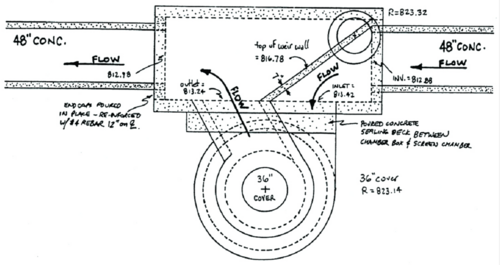
Hydrodynamic devices
Hydrodynamic devices are designed to remove solids, oil/grease, floatables and other debris from stormwater runoff through gravitational trapping of pollutants. They are typically used in combination with other structural BMPs, such as a pre-treatment device.
Contents
Description
Hydrodynamic devices are chambers that allow sediment to settle out of the water column. The devices often enhance the rate of sediment settling through the circular motion of stormwater within the chamber. The devices also capture oil, grease, and other floatables, most often through the use of baffles. Hydrodynamic devices are typically designed to provide optimal removal efficiency for smaller, more frequent storms with minimal removal in larger, less common storms. To maintain removal efficiency, the devices require regular removal of accumulated sediment and floatables.
These devices are proprietary and typically are designed and installed by a manufacturer. Performance data are often provided by the manufacturer. Users should review this information to ensure it was provided by an independent source.
Design criteria
- Expected flow rates
- Pollutants of concern
- Desired removal efficiencies
- Site constraints for size
- Installation and maintenance costs, life of unit
- Need for accessory structures
Benefits
- Units are typically underground and do not consume much site space
- Can often be easily incorporated into fully developed sites
- Can be used for pre-treatment prior to other practices
- Suitable for cold climates if installed below frost line
Limitations
- Each type of unit has specific design constraints and limitations for use
- Treatment may be reduced if frequent maintenance is not conducted
- May not meet local standards when used alone
- Generally good for solids and litter, but much less effective for other common pollutants.
Selection
When selecting or specifying a hydrodynamic device, designers should research the following questions.
- What are the minimum or maximum drainage areas recommended for the device or method?
- What flow rates or volumes can the device accommodate? Will accessory structures be necessary to divert high flow around the hydrodynamic device?
- What are the characteristics of the pollutants in the water used for testing? Research protocols used for testing.
- Are pollutant removal tests verified by independent organizations such as USEPA, University of New Hampshire, University of Minnesota, Wisconsin Department of Natural Resources, or others?
- Does the device contain a bypass for high flows? If so, then what percentage of flow is treated prior to bypass?
- What are the construction costs? Does the cost include all materials, installation, and delivery?
- What are the maintenance requirements? What are the costs of the required maintenance? Is there a standard operation and maintenance plan?
- Does the local regulatory authority allow the use of hydrodynamic devices?
- Will the manufacturer provide design computations and CADD details?
Management suitability
- Water Quality (Vwq) - Applicable
- Channel Protection (Vcp) - Not Applicable
- Overbank Flood Protection (Vp10) - Not Applicable
- Extreme Flood Protection (Vp100) - Not Applicable
- Recharge Volume (VRE) - Not Applicable
Mechanisms
- Infiltration - Not Applicable
- Screening/ Filtration - Applicable
- Temperature Control - Not Applicable
- Settling - Applicable
- Evaporation - Not Applicable
- Transpiration - Not Applicable
- Soil Adsorption - Not Applicable
- Biological/ Micro. Uptake - Not Applicable
Pollutant removal
- Total Suspended Solids - Applicable a
- Nutrients - Total Phosphorus/Total Nitrogen - Not Applicable
- Metals - Cadmium, Copper, Lead, and Zinc - Applicable A
- Pathogens - Coliform, Streptococci, E. Coli - Not Applicable
- Toxins - Hydrocarbon, Pesticide - Not Applicable
a Target pollutants - actual percentage of pollutant removal varies with each device and installation
This page was last edited on 3 December 2022, at 22:52.
